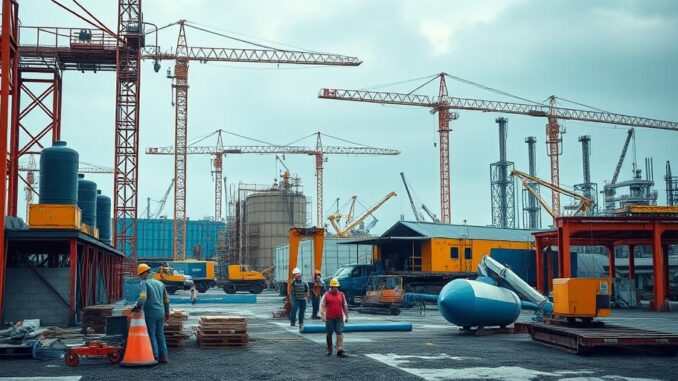
Summary
This article provides a comprehensive 10-step guide to planning the construction of your manufacturing plant. From initial feasibility studies and site selection to equipment needs and safety procedures, each step is crucial for success. Follow these steps to build a thriving and efficient manufacturing facility.
Successful low-energy building design hinges on careful planning. Focus360 Energy can help.
** Main Story**
So, you’re thinking about building a manufacturing plant? That’s a huge undertaking, but with the right planning, it can be a game-changer for your business. Trust me, I’ve seen it done right, and I’ve definitely seen it done wrong. Let’s walk through ten key steps to keep you on the right track.
1. Start with a Solid Foundation: Feasibility and Planning
First things first: is this actually doable? A thorough feasibility study is non-negotiable. We’re talking budget, ROI, and making sure you’re playing by the local rules. Think environmental laws, zoning regulations, the whole shebang. This isn’t just about optimism; it’s about reality. Because without it, you may find yourself on a path to nowhere.
2. Location, Location, Location
Where you build matters big time. Consider where are your suppliers, who are your customers? Are there accessible transport links? What about the local labor pool, and are there readily available utilities? Seriously weigh buying versus leasing. I mean, ownership is tempting for future expansions and all, but leasing can free up capital initially. I once saw a company sink because they bought land in a location that seemed cheap at first but lacked crucial infrastructure. Ouch!
3. Paperwork Power: Permits and Approvals
Ugh, the bureaucracy. But you can’t skip this. Get familiar with local zoning codes, environmental regulations, building permits, and so on. Pro tip: engage with local authorities early. It’ll save you headaches later; trust me on this one. Getting the right approvals, that is, because there’s no point in starting a building without having it all figured out. The permitting process will always, always take longer than you anticipate.
4. Show Me The Money: Financial Planning
Lay out a detailed financial plan. I mean detailed: construction costs, land (if you’re buying), equipment, contingency funds, and potential grants or tax breaks. Look into loans, self-financing, and even TIF programs. It’s smart to understand where all the money will go. Is there funding readily available, or will that cause an issue further down the line? Don’t get caught short!
5. Design for Success: Plant Layout
Work closely with architects and engineers to design a plant that’s both functional and efficient. You want to optimize workflow, minimize wasted movement, and incorporate future expansion plans. Don’t overlook things like occupancy, lighting, HVAC, power, and wall construction. Its an important factor in determining how your building will be organised.
6. Gear Up: Equipment Selection and Procurement
Figure out what equipment you need. Production machinery, material handling, support infrastructure. Plan for procurement. What are the lead times? Any installation quirks? Will it all work together? This stage can’t be rushed, because that leads to disaster.
7. Timeline Tango: Project Schedule
Partner with construction experts to nail down a realistic timeline. From design to commissioning, map it all out. Pad it too, because delays will happen. And have a plan to keep things moving if those delays pop up. Its better to be safe than sorry.
8. Thinking Ahead: Future Expansion
Plan for growth, even if it feels like a distant dream now. Ensure you have enough land and a layout that won’t be a nightmare to expand. Consider modular designs and flexible utility systems. Future you will thank current you!
9. Boots on the Ground: Construction Phase
Oversee construction closely. Make sure everything aligns with the design, meets quality standards, and follows safety rules. Regular communication with the construction team is key. Don’t be afraid to ask questions and address problems quickly. Don’t just assume everything is going to plan.
10. Safety First, Always: Safety Procedures
Prioritize safety above all else. Comprehensive training, safety equipment, emergency procedures, regular inspections – it all matters. A safe workplace protects your people and keeps you compliant. And to be fair, that makes sense. Ultimately, it’s about ensuring everyone goes home safe at the end of the day.
Building a manufacturing plant is a marathon, not a sprint. And if you take it step by step, you won’t struggle. By carefully following these steps, you can build a facility that runs efficiently, supports future growth, and prioritizes a safe environment. Good luck and remember: planning is everything!


The emphasis on engaging with local authorities early in the permitting process is spot on. Building those relationships can significantly streamline approvals and avoid unexpected roadblocks down the line. What strategies have you found most effective in fostering positive relationships with local regulatory bodies?
Thanks for highlighting that point! I’ve found that transparency and proactive communication go a long way. Providing clear, concise information about the project upfront and being open to addressing their concerns early on builds trust. Have you seen similar success with this approach?
Editor: FocusNews.Uk
Thank you to our Sponsor Focus 360 Energy
The point about detailed financial planning is key. Exploring potential grants and tax breaks can significantly impact project feasibility. Are there specific resources or databases you recommend for identifying available incentives?